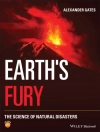Natural hazards are present in every part of planet Earth. Sometimes a natural event – such as extreme weather, a volcanic eruption, earthquake or disease outbreak – turns into a disaster for humans, the environment, and the economy.
Earth’s Natural Hazards and Disasters is a textbook for undergraduates that challenges students to think critically about disasters. It explains the science behind natural events and explores how to understand risk and prepare for disasters.
About this volume:
* Covers hazards in the geosphere, hydrosphere, atmosphere, and biosphere
* Explains the science of hazards in accessible terms
* Detailed case studies of specific disasters for each type of natural event
* Explores data-based risk mitigation strategies
* Discusses the roles of scientists, public officials, and the general public in hazard management
The American Geophysical Union promotes discovery in Earth and space science for the benefit of humanity. Its publications disseminate scientific knowledge and provide resources for researchers, students, and professionals.
Cuprins
Preface
Acknowledgements
Section I – Introduction
Chapter 1 Introduction to Natural Hazards
Section II – Geologic Events as Disasters
Chapter 2 Plate Tectonics
Chapter 3 Volcanoes
Chapter 4 Earthquakes
Chapter 5 Tsunamis
Chapter 6 Earth Movements
Section III – Weather and Climate as Hazards
Chapter 7 The atmosphere and Weather
Chapter 8 Severe Weather
Chapter 9 Floods
Chapter 10 Hurricanes
Chapter 11 Climate Change
Chapter 12 Wildland Fires
Section IV – Other Hazards
Chapter 13 Biological Hazards
Chapter 14 Hazards from Space
Bibliography
Glossary
Index
Despre autor
Bethany D. Hinga, University of Nebraska at Kearney, USA.












